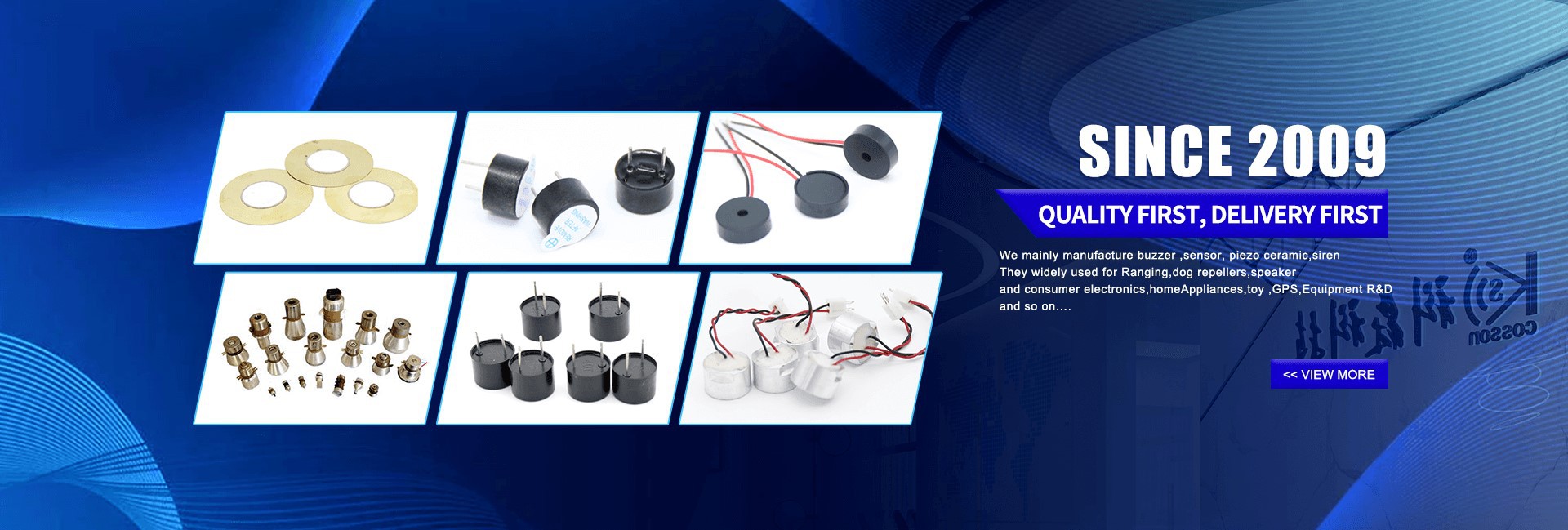Magnetic Buzzer
Foshan cosson Technology Co. Ltd is a professional enterprise engaged in manufacturing buzzer,sensor, piezeceramic, speaker and so on . The company is located in Guandong. Since its inception the company spirit of "Quality first, customer first" business philosophy, full participation, excellence, to provide high-quality products for customers !
Cosson has talent, technology, quality, service, strategy and other advantages.Meanwhile,it is optimizing work flow, casting excellence, continuing to revitalize the brand to maintain the leading position, the vision of a more broad, higher goals and dedicated to creating more value for customers. The company has developed a series of products which are widely used in the production: communication, household appliances, automobiles, electric bicycles, UPS power supply, alarm; instrumentation, electronic toy and electronic clocks and so on.

Why choose us?
01
Quality assurance
Quality is our culture, we believe that the quality is the soul of an enterprise.
02
Good service
Good after-sale service, handling the customer complaint and solve problem for customers.
03
Reasonable price
Our products are complete in variety, good in quality, reasonable in price.
04
Fast delivery
We may promise that we can try our best to finish all of your orders within the shortest time.
What is Magnetic Buzzer
Magnetic buzzers operate using electromagnetic principles. When power is applied, current runs through the coil of wire inside the buzzer, which produces a magnetic field. The flexible ferromagnetic disk is attracted to the coil when the magnetic field is activated, then returns to rest when the magnetic field is off.
Benefits of Magnetic Buzzer
Compact size
Magnetic buzzers are small in size, making them ideal for applications where space is limited. Their compact design allows for easy integration into various electronic devices and systems.
Low power consumption
These buzzers are known for their efficient power usage. They consume minimal power, which is beneficial for battery-operated devices and those requiring energy-efficient solutions.
Reliable performance
Magnetic buzzers are highly reliable and have a long operational life. They are designed to withstand harsh environmental conditions, mechanical stress, and temperature extremes, ensuring consistent performance over time.
Audible sound output
These buzzers produce a loud and attention-grabbing sound, making them suitable for applications where audible alerts or notifications are required. They provide clear and distinct audio signals even in noisy environments.
Easy integration
Magnetic buzzers are designed for surface mounting, allowing for easy and convenient integration into PCBs (Printed Circuit Boards). This streamlined integration process helps manufacturers save time and effort during production.
Seatbelt warning systems
Magnetic buzzers are often used in seatbelt warning systems to alert drivers and passengers when they or their occupants haven't fastened their seatbelts. This audible reminder encourages safety and helps ensure that all passengers are properly secured.
Low fuel warning
Many vehicles use magnetic buzzers to signal low fuel levels to the driver. When the fuel level drops below a certain threshold, the buzzer activates to prompt the driver to refuel.
Door ajar warnings
Magnetic buzzers can be employed to alert drivers when a door, trunk, or hatch is not fully closed or properly secured. This helps prevent accidents and damage caused by doors or trunks inadvertently opening while the vehicle is in motion.
Key-in-ignition reminder
Some vehicles use magnetic buzzers to remind the driver when the ignition key is left in the ignition switch after the engine has been turned off. This helps prevent situations where the key is accidentally left behind.
Turn signal indicators
In older or simpler vehicle models, magnetic buzzers may be used to provide an audible click or sound when the turn signals are activated. This assists the driver in knowing that the turn signal is working.
Reverse gear warning
In some vehicles, magnetic buzzers are used to generate a warning sound when the vehicle is in reverse gear. This warns pedestrians and others in the vicinity that the vehicle is moving backward.
Vehicle security systems
In vehicle security systems, magnetic buzzers can be employed as part of car alarms to generate loud, attention-grabbing sounds when an unauthorized intrusion or security breach is detected.
Sensor-based warnings
Modern vehicles often use various sensors (e.g., proximity sensors, collision avoidance systems) to detect potential dangers or obstacles. Magnetic buzzers can provide audible warnings to the driver when these sensors detect a risk or collision threat.
Maintenance and diagnostic alerts
Magnetic buzzers can be integrated into a vehicle's onboard diagnostics system to alert the driver to maintenance issues or fault codes, such as engine problems or low tire pressure.
Other alerts
Magnetic buzzers can be used for various other alerts and notifications within the vehicle, such as indicating low washer fluid, high engine temperature, or other system warnings.
Parameters of Magnetic Buzzer
Magnetic buzzers are more traditional in their make-up as opposed to piezo buzzers. The current is driven through a voice coil to produce a magnetic field. When a voltage is applied the coil generates a magnetic field and then allows the diaphragm to vibrate and produce sound. This buzzer type has a low operating voltage ranging from 1.5 – 12V, and high current draws, commonly > 20 mA. Magnetic buzzers are desirable for applications requiring a lower sound pressure level (SPL) and frequency.
Resonant frequency
Audio components have a specific frequency at which they vibrate, this parameter is called the resonant frequency. This value is dependent on the physical parameters of the buzzer. Driving a buzzer with an input signal which has the same frequency as the buzzer's resonant frequency, will create the greatest SPL with the least input power. Piezo buzzers have a higher resonant frequency (2-6 kHz) whereas magnetic buzzers have a lower resonant frequency (1-3 kHz). Specification sheets denote resonant frequency as fo.
Frequency and sound pressure level (SPL)
Commonly included on an audio buzzer's data sheet is a "Frequency vs. SPL" graph. The SPL value is referred to as the sensitivity. Sensitivity is the level of sound pressure in front of the speaker (on axis), at a given amount of power, at a specified distance. A lower sensitivity buzzer will generally require higher powered amplifiers.
SPL gives a general idea of how loud audio can play, and how much power will be required to achieve desired listening levels. Sound pressure is typically measured in Decibels (dB) or Pascal's (Pa).
The frequency response value which is measured in Hertz (Hz) is used to describe the audible frequency range that a buzzer can reproduce. The theoretical range of human hearing is generally regarded as being from about 20 Hz (the very lowest bass tones) through 20 kHz (the very highest treble notes). It's common that an amplitude tolerance will be noted along with the frequency response specification and it will often be defined as +/- 3 dB.
Graph interpretation
When interpreting a buzzers Frequency vs SPL graph, the sound pressure is generally measured at a distance of 10cm away, unless otherwise specified. The SPL value is displayed on the y-axis. This parameter has a direct relationship to the voltage used to drive the buzzer. The higher the voltage is the higher the SPL value is. Frequency response (Hz) is indicated on the x-axis.
The curves show how the audio device responds to each frequency. The SPL is plotted to indicate how the buzzer will handle the frequency input. On a piezo buzzer's graph it's notable that the graph has a lot of peaks of amplitude. Electromagnetic components produce a more dynamic range of frequencies with a smoother curve. All buzzers are rated to different frequencies of sound and the sound pressure level is then measured accordingly.
What is the Principle of Magnetic Buzzer Reverse Polarity Protection
The reverse polarity protection in a magnetic buzzer is typically achieved through the use of a diode connected in series with the buzzer coil. The principle behind this protection mechanism is quite straightforward and relies on the electrical properties of diodes. Here's how it works:




Normal (correct) polarity operation
When the buzzer is connected with the correct polarity, meaning the positive voltage is applied to the positive terminal of the buzzer and the negative voltage (or ground) is applied to the negative terminal, current flows through the coil of the buzzer.
Diode forward bias
In this configuration, the diode is forward-biased, allowing current to flow through it. The diode essentially behaves like a closed switch, permitting the flow of electrical current from the positive to the negative terminal of the buzzer.
Buzzer activation
The current flowing through the coil generates a magnetic field, which causes the diaphragm or other vibrating component in the buzzer to vibrate and produce sound, thus activating the buzzer.
Reverse polarity condition
If the polarity is reversed, meaning the positive voltage is applied to the negative terminal and the negative voltage (or ground) is applied to the positive terminal of the buzzer, the diode becomes reverse-biased.
Diode reverse bias
When the diode is reverse-biased, it behaves like an open switch, blocking the flow of current in the wrong direction. This effectively prevents current from flowing through the buzzer coil in reverse polarity conditions.
Buzzer deactivation
Because the current is blocked due to the reverse-biased diode, the buzzer does not activate when reverse polarity is applied. This protects the buzzer's internal components from potential damage that could occur if it were powered in reverse polarity.
The reverse polarity protection in a magnetic buzzer relies on the diode's ability to block current flow in the reverse direction. This ensures that the buzzer only operates when connected with the correct polarity, preventing damage and ensuring proper functionality. It's a simple yet effective method to safeguard the buzzer from incorrect wiring.
The Driving Circuit of Magnetic Buzzer
Buzzer
When DC voltage (active buzzer) or square wave (passive buzzer) is applied at both ends of the sounding element, its main parameters are the shape dimension, sound direction, working voltage, working frequency, working current, driving mode (DC / square wave), etc., which can be selected according to the needs.
01
Freewheeling diode
The buzzer is essentially an inductive element, and its current can not be transiently changed. Therefore, a freewheeling diode must be provided for the continuous current. Otherwise, a spike voltage of tens of volts will be generated at both ends of the buzzer, which may damage the driving triode and interfere with other parts of the whole circuit system.
02
Filter capacitor
The function of filter capacitor C1 is to filter the influence of buzzer current on other parts and improve the AC impedance of power supply. If possible, it is better to connect a 220uF electrolytic capacitor in parallel.
03
Triode
The high level of the base makes the triode turn on saturated and make the buzzer sound; while the low level of the base makes the triode close and the buzzer stops sounding.
04

Operating voltage and current
As for the piezoelectric buzzer, it is a voltage-driven device that has a wider operating voltage and it’s between 3V to 220V, while the current is usually less than 20mA.
In contrast, magnetic buzzers are essentially current-driven devices and usually requires more than 20mA to operate. The applied voltage can be as low as 1.5V or up to about 12V.
So, in order to make your product work smoothly, it is advisable not to exceed the operating voltage range of a buzzer.
Sound pressure level
When buying a buzzer, the Sound Pressure Level (SPL) should also be taken into consideration. The buzzer usually uses a distance of 10cm as the test standard. It is generally proportional to the input voltage. For example, if the distance is increased doubly, it will attenuate by 6dB, otherwise, if the distance is decreased to half, the SPL will increase by 6dB.
The magnetic buzzer can reach the level of 85dB / 10cm, and the piezoelectric type has louder SPL.
Size
The size of the buzzer will affect the SPL and the frequency. The size of the magnetic type is from a minimum of 7mm to a maximum of 25mm, and the piezoelectric type is from 12mm to 50mm or more.
Drive mode
Piezoelectric and magnetic buzzers have different self-drive modes they use. Both buzzers have a self-excited type, also called indicator which has the internal set drive circuits, and thus the buzzer can create sounds as long as it interacts with the direct current.
Also, because of the different work principles they have, they run differently. So, the magnetic buzzer can be driven by ½ square waves, while the piezoelectric buzzers may need full square waves for better results.
How to Choose the Right Magnetic Buzzer
Dimensions
The size of the buzzer affects the volume and frequency. The smallest electromagnetic type ranges from 7mm to the largest 25mm, and the piezoelectric type ranges from 12mm to 50mm or more.
Operating voltage
An electromagnetic buzzer from 1.5 to 24V, piezoelectric from 3V to 220V is feasible. Generally, piezoelectric is still recommended to have a voltage of 9V or more to get a larger sound.
Current consumption
There are different types of electromagnetic buzzers in different voltages, from tens to hundreds of milliamps are available. The piezoelectric type is much more power-saving.
Mounting methods
Generally, there are pin (DIP), solder wire, SMD, and mounting screw methods.
Sound pressure
The buzzer test standard is 10cm distance. When the distance doubled, about 6dB will be attenuated. On the contrary, vice versa, the distance shortened by 6dB. An electromagnetic buzzer can reach about 85dB/10cm level. Piezoelectric can do very loud. That’s why most of the common sirens are usually made of piezoelectric buzzers.
Driving type
Both active magnetic buzzers and active piezo buzzers are self-excited and can be sounded as long as they are connected to direct current (DC) because the driving circuit is already built into the buzzer. The electromagnetic buzzer has to be driven by 1/2 square wave and the piezoelectric one by square wave to having a better sound output.
Certifications

Our Factory
We attach great importance to, cherish all cooperation or cooperative partner of customers, to express the trust and expectations of our customers.Cosson's team of professional skills, has a very enthusiastic, with a lofty ideals and high aspirations enthusiasm and look forward to customers, together with the Chinese The electronic industry is booming as a modest, attained brilliant. Partnership, abide by integrity, common development!We firmly believe that the goods of electronic will continue to forge ahead, and you work together to create a better future! We hope to work with all of our overseas partners.Let's do it even better!




















